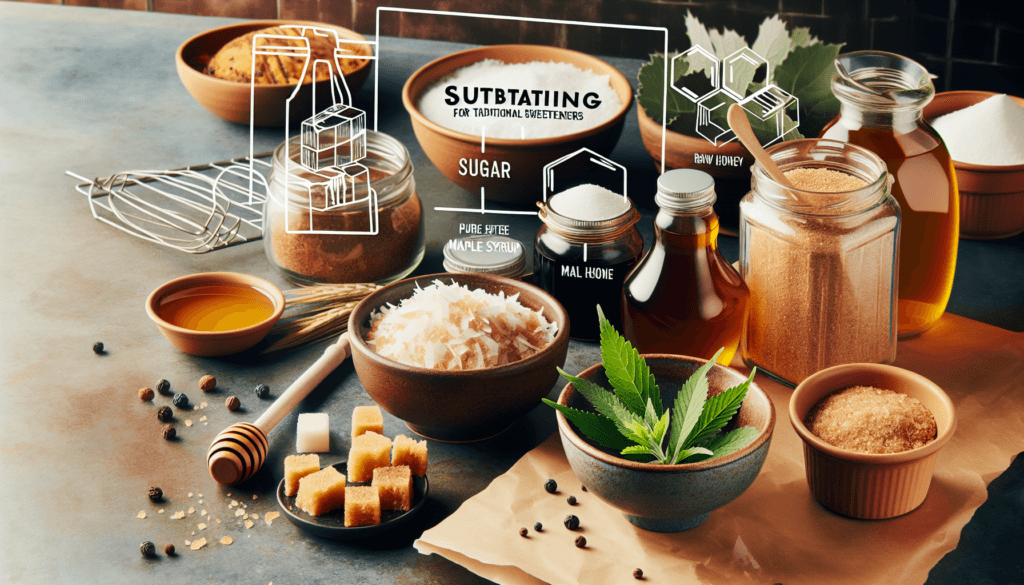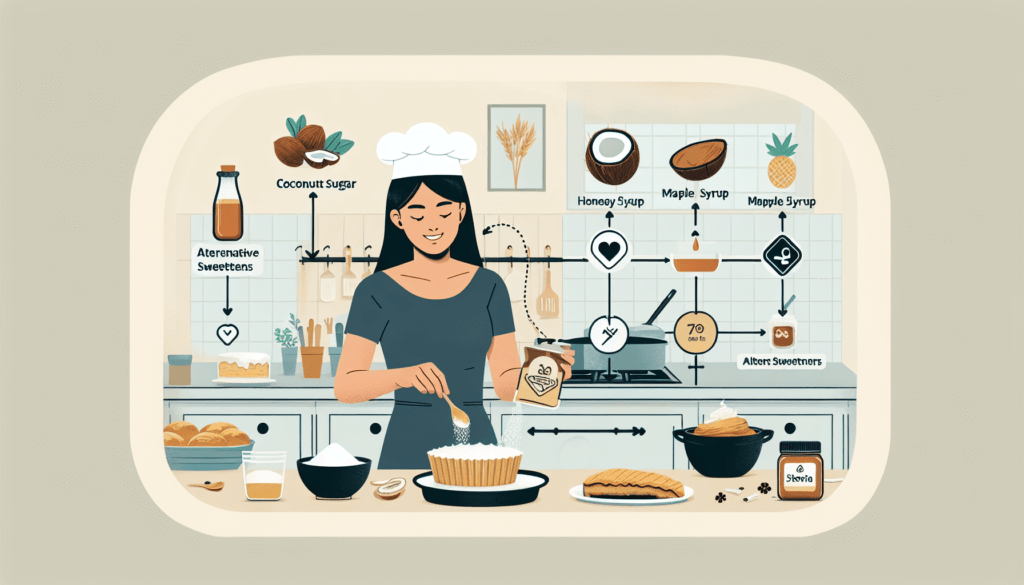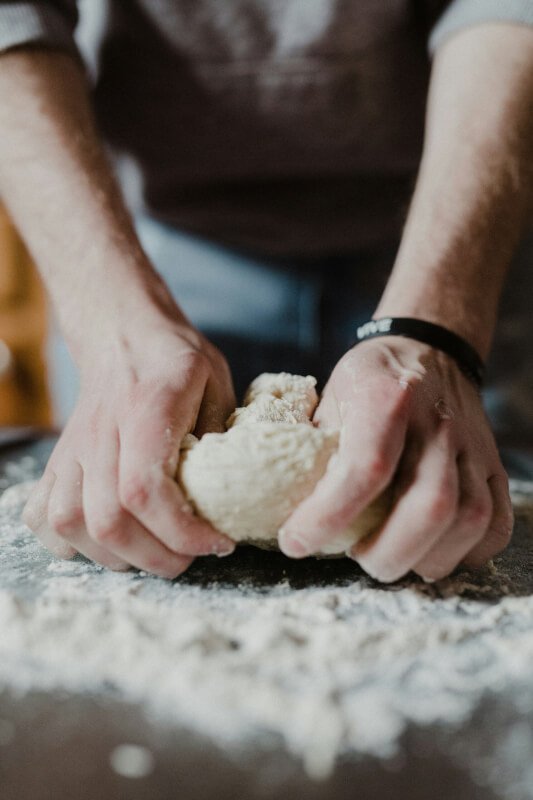Are you looking to satisfy your sweet tooth while still keeping your health in check? Look no further! In “The Ultimate Guide to Baking with Alternative Sweeteners,” you will discover a treasure trove of information on how to incorporate alternative sweeteners into your baking and still enjoy delicious treats. From stevia to agave nectar, we will explore the various options available and provide expert tips and tricks to ensure your baked goods come out perfectly every time. Say goodbye to refined sugar and hello to guilt-free indulgence with our comprehensive guide. Get ready to embark on a delightful journey of flavor and learn how to make healthier choices in the world of baking.

Types of Alternative Sweeteners
Natural Sweeteners
Natural sweeteners are derived from natural sources such as plants or fruits. They provide a sweet taste without the harsh chemicals often found in artificial sweeteners. Some popular natural sweeteners include honey, maple syrup, agave nectar, and molasses.
Artificial Sweeteners
Artificial sweeteners are artificially synthesized compounds that mimic the taste of sugar. They are often used as a sugar substitute in various food and beverage products. Some common artificial sweeteners include aspartame, sucralose, and stevia.
Sugar Alcohols
Sugar alcohols are a type of carbohydrate that occur naturally in some fruits and vegetables. They provide a sweet taste with fewer calories than regular sugar. Common sugar alcohols include xylitol, erythritol, and maltitol.
Plant-Based Sweeteners
Plant-based sweeteners are derived from various plants and offer a natural alternative to traditional sugar. They are often praised for their low glycemic index and minimal processing. Some examples of plant-based sweeteners include coconut sugar, date sugar, and monk fruit extract.
Understanding Alternative Sweeteners
Glycemic Index
The glycemic index measures how quickly a carbohydrate-containing food raises blood sugar levels. Alternative sweeteners are often preferred by individuals with diabetes or those looking to manage their blood sugar levels. Natural sweeteners like stevia and artificial sweeteners like sucralose have a low glycemic index.
Caloric Content
One of the primary reasons people turn to alternative sweeteners is to reduce calorie intake. Natural sweeteners like honey and maple syrup contain calories, while artificial sweeteners and sugar alcohols provide a sweet taste with little to no caloric content.
Taste
Taste is a significant factor when choosing an alternative sweetener for baking. Different sweeteners offer varying degrees of sweetness and can impact the overall taste of the finished product. Experimenting with different sweeteners and finding the one that best matches your taste preferences is essential.
Baking Properties
Alternative sweeteners may have different baking properties compared to traditional sugar. Some sweeteners, such as honey and maple syrup, add moisture to baked goods, while others, like sugar alcohols, tend to have a cooling effect. Understanding how each sweetener behaves in baking can help you achieve the desired results.

Substituting Alternative Sweeteners in Baking
Conversion Rates
When substituting alternative sweeteners for traditional sugar in a recipe, it’s crucial to understand the conversion rates. Each sweetener has a different level of sweetness, so adjustments may be necessary. Many alternative sweeteners have conversion charts available to help ensure the correct amount is used.
Effect on Texture
Alternative sweeteners can affect the texture of baked goods. Some may contribute to a softer texture, while others may result in a drier or denser final product. Understanding the impact of different sweeteners on texture can guide you in selecting the right sweetener for your desired outcome.
Adjusting Other Ingredients
When using alternative sweeteners in baking, it may be necessary to make adjustments to other ingredients to maintain the proper balance and consistency. Adding extra moisture, such as applesauce or yogurt, can help compensate for the reduced moisture content in some alternative sweeteners.
Recipe Adaptation Tips
Adapting recipes to include alternative sweeteners may require some trial and error. Start by replacing a portion of the sugar with the desired alternative sweetener, gradually increasing the amount over time. Keep track of any adjustments made and their impact on the final product to refine your recipes.
Baking with Natural Sweeteners
Honey
Honey is a natural sweetener made by bees from the nectar of flowers. It adds a unique flavor profile to baked goods and provides moisture. It is sweeter than sugar, so be sure to adjust the amount used in recipes accordingly. Honey can be used as a substitute for sugar in a 1:1 ratio in most cases.
Maple Syrup
Maple syrup is derived from the sap of maple trees and has a distinct rich flavor. It can be used as a sweetener in baking and adds moisture to recipes. When using maple syrup as a sugar substitute, use around 3/4 cup for every 1 cup of sugar. Adjust other liquid ingredients in the recipe to maintain the desired consistency.
Agave Nectar
Agave nectar is a natural sweetener derived from the sap of the agave plant. It is sweeter than sugar and has a milder flavor. When using agave nectar as a sugar substitute, use around 2/3 cup for every 1 cup of sugar. Reduce the liquid in the recipe to compensate for the added moisture.
Molasses
Molasses is a byproduct of the sugar refining process and has a distinctive rich and robust flavor. It adds moisture and enhances the taste of baked goods. When using molasses as a sugar substitute, use approximately 1/2 cup for every 1 cup of sugar. Adjust other ingredients to account for the stronger flavor.

Baking with Artificial Sweeteners
Stevia
Stevia is a popular artificial sweetener extracted from the leaves of the stevia plant. It is incredibly sweet, and only a small amount is needed compared to sugar. When using stevia in baking, it’s best to use a product specifically designed for baking that contains a bulking agent. Follow the manufacturer’s instructions for substitution ratios.
Aspartame
Aspartame is an artificial sweetener that is commonly found in diet sodas and other sugar-free products. It’s not recommended for baking, as it breaks down at high temperatures and may result in a loss of sweetness. Aspartame is best used in cold or no-bake recipes.
Sucralose
Sucralose is an artificial sweetener that is commonly sold under the brand name Splenda. It is popular as a sugar substitute in baking due to its heat stability and ability to retain sweetness. When using sucralose in recipes, follow the manufacturer’s recommended conversion ratios or use a sugar substitute specifically formulated for baking.
Baking with Sugar Alcohols
Xylitol
Xylitol is a sugar alcohol commonly derived from birch trees or corn. It has a similar sweetness to sugar and is often used as a sugar substitute in baking. Xylitol can add moisture to baked goods, so adjusting the liquid content may be necessary. Use xylitol in a 1:1 ratio as a substitute for sugar in most recipes.
Erythritol
Erythritol is a sugar alcohol that occurs naturally in fruits and fermented foods. It provides a sweet taste without the caloric content of sugar and has a cooling effect. Erythritol can be used as a 1:1 substitute for sugar in recipes, but it may have a slightly different texture and taste.
Maltitol
Maltitol is a sugar alcohol commonly derived from corn or wheat. It is used as a sugar substitute in many sugar-free products, including baked goods. Maltitol provides a similar sweet taste to sugar but can have a laxative effect if consumed in large quantities. Use maltitol in a 1:1 ratio as a substitute for sugar, but be mindful of its potential side effects.

Baking with Plant-Based Sweeteners
Coconut Sugar
Coconut sugar is derived from the sap of coconut palm trees and has a similar taste to brown sugar. It adds a subtle caramel flavor to baked goods and can be used as a 1:1 substitute for sugar in most recipes. However, keep in mind that coconut sugar can make baked goods denser, so adjustments to other ingredients may be necessary.
Date Sugar
Date sugar is made from dried, finely ground dates. It provides a rich flavor and can add moisture to baked goods. Due to its coarse texture, date sugar may not dissolve completely in recipes, so it works best in recipes where the granules add texture and flavor. Use date sugar as a 1:1 substitute for sugar in most recipes.
Monk Fruit Extract
Monk fruit extract is a natural sweetener derived from the monk fruit. It is incredibly sweet, and only a small amount is needed. Monk fruit extract can be used as a sugar substitute in baking, but it may not provide the same texture and browning properties as sugar. Adjustments to other ingredients may be necessary.
Tips for Successful Baking with Alternative Sweeteners
Measuring Correctly
When using alternative sweeteners in baking, it’s important to measure accurately. Use measuring cups or a kitchen scale to ensure the correct amount is used. Some sweeteners, like honey or maple syrup, can be sticky, so using a non-stick cooking spray or lightly greasing the measuring cup can help prevent sticking.
Balancing Flavors
Each alternative sweetener has its own unique flavor profile, which can impact the overall taste of the baked goods. Experiment with different sweeteners to find the one that complements the other flavors in your recipe. Adding spices, extracts, or citrus zest can also help balance out the flavors.
Adding Moisture
Alternative sweeteners like honey or agave nectar can add moisture to baked goods, resulting in a softer texture. If using these sweeteners, reduce the amount of liquid in the recipe accordingly. On the other hand, some sweeteners may have a drying effect, so adding extra moisture in the form of applesauce, yogurt, or oil may be necessary.
Reducing Baking Time
Some alternative sweeteners, such as sugar alcohols, can cause baked goods to brown more quickly. Keep an eye on your baked goods and reduce the baking time if necessary. Using a lower oven temperature or covering lightly with foil can also help prevent excessive browning.

Recipes Using Alternative Sweeteners
Chocolate Chip Cookies with Stevia
Ingredients:
- 1 cup butter, softened
- 1 cup stevia baking blend
- 2 eggs
- 1 tsp vanilla extract
- 2 1/4 cups all-purpose flour
- 1 tsp baking soda
- 1/2 tsp salt
- 1 1/2 cups chocolate chips
Instructions:
- Preheat the oven to 375°F (190°C) and line baking sheets with parchment paper.
- In a mixing bowl, cream together the softened butter and stevia baking blend until light and fluffy.
- Add the eggs and vanilla extract, mixing well until combined.
- In a separate bowl, whisk together the flour, baking soda, and salt.
- Gradually add the dry ingredients to the wet ingredients, mixing until just combined.
- Fold in the chocolate chips.
- Drop rounded tablespoons of dough onto the prepared baking sheets, spacing them about 2 inches apart.
- Bake for 9-11 minutes, or until the edges are golden brown.
- Allow the cookies to cool on the baking sheet for a few minutes before transferring them to a wire rack to cool completely.
Vegan Banana Bread with Maple Syrup
Ingredients:
- 3 ripe bananas, mashed
- 1/2 cup maple syrup
- 1/4 cup coconut oil, melted
- 1 tsp vanilla extract
- 2 cups all-purpose flour
- 1 tsp baking soda
- 1/2 tsp salt
- 1/2 cup chopped walnuts (optional)
Instructions:
- Preheat the oven to 350°F (175°C) and grease a loaf pan.
- In a mixing bowl, combine the mashed bananas, maple syrup, melted coconut oil, and vanilla extract.
- In a separate bowl, whisk together the flour, baking soda, and salt.
- Gradually add the dry ingredients to the wet ingredients, stirring until just combined.
- Fold in the chopped walnuts, if desired.
- Pour the batter into the prepared loaf pan and smooth the top.
- Bake for 50-60 minutes, or until a toothpick inserted into the center comes out clean.
- Allow the banana bread to cool in the pan for 10 minutes before transferring it to a wire rack to cool completely.
Sugar-Free Brownies with Erythritol
Ingredients:
- 1/2 cup unsweetened cocoa powder
- 1/2 cup almond flour
- 1/2 cup erythritol
- 1/4 tsp salt
- 1/4 tsp baking powder
- 1/2 cup melted coconut oil
- 3 large eggs
- 1 tsp vanilla extract
- 1/2 cup chopped sugar-free chocolate or chocolate chips
Instructions:
- Preheat the oven to 350°F (175°C) and line an 8×8-inch baking dish with parchment paper.
- In a mixing bowl, whisk together the cocoa powder, almond flour, erythritol, salt, and baking powder.
- In a separate bowl, whisk together the melted coconut oil, eggs, and vanilla extract.
- Gradually add the wet ingredients to the dry ingredients, stirring until just combined.
- Fold in the chopped sugar-free chocolate or chocolate chips.
- Pour the batter into the prepared baking dish and smooth the top.
- Bake for 20-25 minutes, or until the edges are set and the center is still slightly fudgy.
- Allow the brownies to cool in the pan before cutting into squares.
Health Considerations and Safety
Allergies and Sensitivities
When using alternative sweeteners, it’s important to consider any allergies or sensitivities. Some people may have allergic reactions to certain sweeteners, such as those derived from tree nuts or fruits. Always read ingredient labels carefully and consult a healthcare professional if you have any concerns.
Effects on Blood Sugar
Alternative sweeteners are often used as a sugar substitute to help manage blood sugar levels. However, it’s important to note that some sweeteners, such as sugar alcohols, can still have an impact on blood sugar. Individuals with diabetes or other health conditions should monitor their blood sugar levels and consult a healthcare professional before making significant changes to their diet.
Potential Side Effects
Certain alternative sweeteners, especially sugar alcohols, can cause digestive issues such as bloating, gas, or diarrhea when consumed in large quantities. It’s important to consume these sweeteners in moderation and be aware of their potential side effects. If you experience any adverse reactions, discontinue use and consult a healthcare professional.
Safe Usage Guidelines
Each alternative sweetener has its own safe usage guidelines. Follow the recommended serving sizes and daily intake limits provided by the manufacturer. It’s also important to store sweeteners properly to prevent spoilage or contamination. Keep them in a cool, dry place away from direct sunlight.
In summary, alternative sweeteners offer a variety of options for those looking to reduce their sugar intake or manage blood sugar levels. Whether you choose natural sweeteners, artificial sweeteners, sugar alcohols, or plant-based sweeteners, understanding their characteristics and properties can help you achieve delicious and satisfying baked goods. Experimenting with different recipes and adjusting other ingredients as needed will allow you to enjoy the sweetness of baking while using alternative sweeteners in a safe and thoughtful manner.


